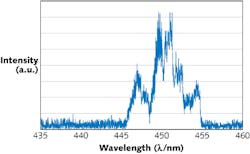Researchers from Shimadzu (Kanagawa, Japan) have created a blue-emitting direct-diode laser that focuses light from 30 individual 450-nm-emitting gallium nitride (GaN)-based laser diodes into an optical fiber with a 100-μm-diameter core; the direct-diode laser produces 50 W of optical power at a numerical aperture (NA) of 0.2. One of the notable characteristics of this laser is its electrical-power to light-conversion (wall-plug) efficiency of 20%.
The laser’s wavelength is much better suited than light from infrared (IR) lasers for certain materials-processing applications—for example, machining copper (Cu) and gold (Au). While Cu and Au are highly reflective in the IR region, their reflectance drops sharply below a 600 nm wavelength.
Pre-existing IR materials-processing lasers include carbon dioxide (CO2) lasers emitting at 10.6 μm, fiber lasers emitting near 1 μm, and conventional direct-diode lasers emitting near 900 nm; for Cu and Au, these lasers lead to the requirements of high output and/or pretreating the metal to be machined with a coating of light-absorbing material. In contrast, the 450 nm wavelength of the Shimadzu direct-diode laser results in an order-of-magnitude higher absorption than IR lasers, say the Shimadzu researchers.
There are three ways to incoherently combine the light beams from many laser diodes into one fiber: 1) spatial multiplexing, in which collimated beams from all the laser diodes are aligned in parallel and sent through a lens that focuses the resulting beam onto the input end of the fiber; 2) spectral multiplexing, in which light from laser diodes of different wavelengths is combined using dichroic optics); and 3) polarization multiplexing, where two beams of differing polarizations are combined with polarization optics.
Spatially multiplexed
For their initial efforts, the researchers decided to forgo spatial multiplexing, as that approach requires preparing light sources with multiple wavelengths and produces an output with a broader spectrum; they also nixed polarization multiplexing, with its maximum of a factor-of-two increase in the original output level.
They started with a basic unit containing five laser diodes; two of these units were spatially combined to make a 10 W direct diode laser whose output is high enough on its own to anneal amorphous silicon or weld plastics. The direct-diode laser has a beam quality (M2) of 73 in both x and y, which is consistent with the theoretical M2 value of 70 for the output of a 100 μm, 0.2 NA fiber at a 450 nm wavelength.
The 10 W laser shows a wavelength variability of less than 0.04 nm/°C over the 15°C to 30°C temperature range, and has an output stable to within 1% over an 80 h period at 20°C and a spectral width of about 10 nm (see Fig. 1). The linewidth of a single blue laser diode is about 2 nm, so the researchers allowed for variability between laser diodes in their design; if a narrower linewidth is desired, more-similar laser diodes can be selected. The 10 W laser is now a product.
The Shimadzu team then used the same spatial multiplexing approach to create a 50 W laser (see Fig. 2); this laser has undergone a long-term 1000-h test that confirmed that the optical fiber was immune to darkening caused by the high-intensity blue light, according to Kazuma Watanabe, one of the researchers.Future research includes higher-power lasers of this type. “In the near term, we intend to further develop the laser system by increasing not only optical output power, but also optical brightness by using a fiber with smaller core size than 100 μm,” says Watanabe. “In the long term, we are planning to develop high-brightness laser systems at various wavelengths; then we will combine several wavelengths of these high-brightness laser systems into a fiber.”


